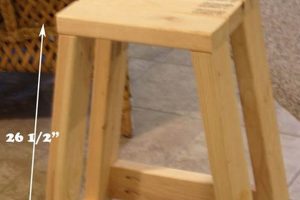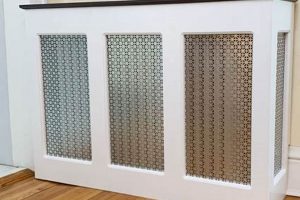The activity involves constructing miniature dwellings from cardboard, resembling the traditional baked confection. These structures are assembled and decorated to emulate the appearance of edible gingerbread houses, providing a creative and accessible alternative for holiday crafts. The process often involves cutting and gluing cardboard pieces to form walls, roofs, and other architectural elements, followed by embellishment with paint, glitter, and other decorative materials.
Engaging in this craft promotes creativity, problem-solving skills, and fine motor development. It offers a cost-effective and environmentally conscious option for holiday decorations, utilizing readily available materials like recycled cardboard. The practice provides an opportunity for collaborative projects, fostering teamwork and shared artistic expression. While the concept of edible gingerbread houses has a long history tied to culinary traditions and celebrations, this variation offers a durable and non-edible alternative, extending the enjoyment of the holiday spirit.
The subsequent sections will detail essential materials, provide step-by-step instructions for constructing the base structure, offer suggestions for decorative techniques, and explore methods for creating unique architectural designs. The article will also cover safety considerations and provide tips for adapting the project for different skill levels and age groups.
Crafting Durable Cardboard Gingerbread Structures
Constructing a lasting cardboard structure requires careful planning and execution. The following tips are designed to improve the structural integrity and aesthetic appeal of the finished product.
Tip 1: Select Appropriate Cardboard: Opt for corrugated cardboard with a high crush resistance. Single-layer cardboard is often insufficient for larger structures. Consider the weight of the decorative elements when selecting cardboard thickness.
Tip 2: Precise Cutting is Crucial: Utilize a sharp utility knife and a metal ruler for accurate cuts. Uneven edges compromise the structural integrity of the house and affect its overall appearance. Replace blades frequently to maintain sharpness.
Tip 3: Reinforce Joints: Apply a strong adhesive, such as hot glue or construction adhesive, liberally to all joints. Consider using cardboard strips or wooden dowels to reinforce corners and edges for added stability.
Tip 4: Plan the Design: A well-defined blueprint is essential. Accurately measure and map out all components before commencing construction. Account for the thickness of the cardboard when calculating dimensions.
Tip 5: Allow Adequate Drying Time: Adhesives require sufficient time to cure fully. Avoid moving or handling the structure until the adhesive has reached its maximum bond strength. Refer to the adhesive manufacturer’s instructions for specific drying times.
Tip 6: Consider Internal Support: For larger structures, internal cardboard supports, such as vertical beams, can provide additional reinforcement and prevent warping or collapsing.
Tip 7: Weatherproof the Exterior: If the structure will be displayed outdoors, apply a sealant to protect the cardboard from moisture. Multiple coats may be necessary for adequate protection.
Adhering to these guidelines ensures a robust and visually appealing festive structure. The added strength enhances longevity, allowing the display to last through the holiday season and beyond.
The following section will discuss common decorative techniques to further enhance the realism and charm of the constructed piece.
1. Durable Cardboard Selection
The selection of durable cardboard is paramount to the success of any “cardboard gingerbread house diy” project. It directly influences the structural integrity, longevity, and overall aesthetic appeal of the finished construction. Without a suitable material base, even the most meticulously planned design can be compromised.
- Corrugation Type and Thickness
Corrugated cardboard, characterized by its layered structure with a fluted inner sheet, offers superior strength compared to single-layer cardboard. The thickness of the cardboard, often measured in terms of flute height and board grade, dictates its resistance to bending and compression. Thicker cardboard is generally preferable for larger, more elaborate structures or for houses intended for repeated use.
- Board Grade and Weight Capacity
Cardboard grade refers to the material’s density and the weight it can withstand without collapsing. Higher-grade cardboard is produced from stronger fibers and more tightly compressed layers. This property is particularly important if the house will be adorned with heavy decorations or subjected to potential stress during handling and display. Selecting an appropriate grade ensures the structure maintains its shape and stability.
- Moisture Resistance Considerations
Cardboard’s inherent vulnerability to moisture necessitates careful consideration, especially if the gingerbread house will be displayed in humid environments or outdoors. Moisture weakens the cardboard fibers, leading to warping, sagging, and eventual structural failure. Treatments or coatings designed to enhance moisture resistance can significantly extend the lifespan of the construction.
- Source and Environmental Impact
The source of the cardboard also merits consideration. Utilizing recycled cardboard promotes environmental sustainability and reduces waste. However, the quality of recycled cardboard can vary, so it is essential to assess its condition and structural integrity before use. Choosing responsibly sourced cardboard aligns the project with environmentally conscious practices.
In conclusion, durable cardboard selection transcends mere material procurement; it represents a foundational decision that shapes the feasibility, durability, and aesthetic outcome of the entire “cardboard gingerbread house diy” endeavor. Prioritizing appropriate cardboard types and characteristics contributes directly to a successful and long-lasting festive creation.
2. Precise Structural Assembly
Precise structural assembly constitutes a crucial element in the successful execution of “cardboard gingerbread house diy” projects. The accuracy with which cardboard components are cut, aligned, and joined directly influences the stability, aesthetic quality, and overall feasibility of the final structure. Insufficient precision at this stage can lead to a cascade of problems, including structural instability, misalignment of decorative elements, and a compromised final appearance. For instance, if the walls of the cardboard house are not cut to the specified dimensions and assembled with perpend
icular accuracy, the roof may not fit properly, resulting in a structurally unsound and visually unappealing product. In cases involving more complex designs, deviations from precise assembly can compound, rendering the entire structure unstable and unable to support decorative additions.
The application of precise structural assembly extends beyond merely adhering to measurements; it encompasses the skillful manipulation of joining techniques. Employing appropriate adhesives, ensuring adequate drying times, and utilizing reinforcing elements, such as cardboard gussets or internal supports, contributes significantly to the structural integrity of the cardboard gingerbread house. Consider the example of a multi-story cardboard gingerbread house. Without precise assembly and reinforcement of the lower levels, the upper stories may exert undue stress, leading to collapse. Likewise, the accurate alignment of windows and doors is essential for achieving a realistic and visually pleasing aesthetic. This requires meticulous cutting and careful attachment to ensure a seamless integration into the overall design.
In summary, precise structural assembly serves as a cornerstone for successful “cardboard gingerbread house diy” endeavors. It dictates the stability, visual appeal, and longevity of the finished product. While the creative decoration of a cardboard gingerbread house often receives considerable attention, the underlying structural integrity, achieved through meticulous assembly, is paramount. Overcoming challenges in this area necessitates careful planning, accurate execution, and a thorough understanding of basic structural principles. Ultimately, mastery of precise assembly techniques elevates the “cardboard gingerbread house diy” project from a simple craft activity to a durable and aesthetically satisfying creation.
3. Creative Decoration Techniques
Creative decoration techniques represent a pivotal element in the successful realization of a “cardboard gingerbread house diy” project. The application of these techniques transforms a basic cardboard structure into a visually compelling and festive display. The absence of imaginative decoration renders the project incomplete, failing to capture the essence of traditional gingerbread houses and diminishing its overall appeal. For example, the strategic use of white paint or textured materials can effectively simulate icing, while strategically placed candies or miniature ornaments contribute to the aesthetic authenticity. The integration of these embellishments has a direct causal relationship with the final product’s visual impact, converting a plain cardboard form into an engaging holiday-themed display. The careful selection and application of decorative components dictates whether the finished piece resembles a rudimentary craft project or a meticulously designed miniature dwelling.
Beyond visual appeal, the application of various decorative techniques offers an opportunity for individual expression and personalization. Utilizing different colors, textures, and patterns allows constructors to create unique architectural designs, incorporating elements of personal style. For instance, one individual might opt for a minimalist aesthetic, employing clean lines and subdued colors, while another may favor a more elaborate design, incorporating intricate details and vibrant hues. Furthermore, the selection of specific embellishments, such as miniature figurines or personalized signage, transforms the gingerbread house from a generic decoration into a personalized keepsake. The capacity for customization enables participants of varying skill levels to adapt the project to their individual preferences and resources, making it an accessible and rewarding crafting experience.
In conclusion, the skillful implementation of creative decoration techniques is essential for realizing the full potential of a “cardboard gingerbread house diy” project. It is through the judicious application of embellishments, colors, and patterns that the cardboard structure transcends its utilitarian origins, evolving into a visually captivating and personally meaningful work of art. The integration of creative decoration techniques is not merely a superficial addition; it forms an integral part of the crafting process, impacting both the aesthetic outcome and the personal significance of the finished cardboard gingerbread house.
4. Safe Adhesive Usage
Safe adhesive usage is a critical component in “cardboard gingerbread house diy” projects. The structural integrity and durability of the cardboard construction are directly contingent upon the proper application of adhesives. Failure to adhere to safety guidelines presents risks, ranging from minor irritations to severe health consequences. For example, improper ventilation during the use of certain solvent-based adhesives can lead to respiratory distress and neurological effects. Furthermore, skin contact with some adhesives may induce allergic reactions or chemical burns. Thus, responsible selection and application of adhesives are indispensable for ensuring a safe and successful crafting experience.
The practical implications of safe adhesive usage extend beyond personal well-being. The strength and longevity of the cardboard structure are directly related to the choice of adhesive and its application method. Using an inadequate adhesive, or failing to allow sufficient drying time, can result in a structurally unsound house that collapses under its weight or the weight of decorations. In contrast, the selection of a non-toxic adhesive, coupled with appropriate application techniques, ensures a durable and safe structure that can be enjoyed throughout the holiday season. For projects involving children, non-toxic, water-based adhesives are essential to minimize the risk of accidental ingestion or skin irritation. Real-world examples demonstrate the benefits of planning, appropriate selection, and adherence to safety instructions. A cardboard gingerbread house built with a hot glue gun without proper safety precautions results in burn or injury.
In summary, safe adhesive usage represents an integral aspect of any “cardboard gingerbread house diy” project. Adherence to safety guidelines protects participants from potential health hazards, while the proper selection and application of adhesives contribute to the structural integrity and longevity of the final construction. Challenges in this area often stem from a lack of awareness regarding the potential risks associated with certain adhesives, or from a failure to follow manufacturer instructions. However, by prioritizing safety and exercising caution, individuals can successfully create durable and visually appealing cardboard gingerbread houses without compromising their health or well-being.
5. Design Scalability
Design scalability, within the context of “cardboard gingerbread house diy,” refers to the ability to adjust the complexity and dimensions of the structure based on available resources, skill level, and intended purpose. A design that scales effectively allows individuals with limited experience and materials to create a simple, yet satisfying, cardboard gingerbread house, while simultaneously enabling more advanced crafters to construct elaborate an
d expansive architectural masterpieces. For instance, a novice might opt for a single-story house with basic geometric shapes, whereas an experienced builder could undertake a multi-story Victorian-style gingerbread mansion complete with intricate detailing. Design scalability determines the accessibility and inclusivity of the crafting activity, ensuring that it can be enjoyed by a wide spectrum of participants. When a design lacks scalability, it limits participation, discouraging beginners and potentially stifling the creativity of experienced crafters who may find the project too restrictive.
The practical significance of design scalability manifests in numerous ways. It influences material requirements, time investment, and the technical skills needed for successful completion. A scalable design allows individuals to begin with a small, manageable project, gradually increasing complexity as their skills and confidence grow. This incremental approach reduces the risk of frustration and abandonment, promoting a positive crafting experience. Moreover, design scalability facilitates resource optimization. Builders can adapt the size and complexity of their cardboard gingerbread house to match the amount of cardboard available, minimizing waste and promoting sustainable practices. Educational settings benefit from scalable designs, permitting instructors to tailor the project to suit the varying skill levels within a classroom, allowing for a more productive learning environment.
In summary, design scalability is an essential element of “cardboard gingerbread house diy.” Its presence ensures inclusivity, promotes skill development, and facilitates resource optimization. Recognizing the importance of scalability allows designers and crafters to create cardboard gingerbread house projects that are both challenging and rewarding, regardless of individual skill levels or resource constraints. The absence of scalability presents a barrier to entry, limiting participation and stifling creativity, therefore emphasizing its importance to all project development.
Frequently Asked Questions
The following questions address common inquiries regarding the creation of cardboard gingerbread houses. These responses are intended to provide clarity and guidance for successful project execution.
Question 1: What type of adhesive provides the strongest bond for cardboard construction?
Hot glue provides a rapid and strong bond suitable for many cardboard joints. However, construction adhesive may offer superior long-term durability, particularly for load-bearing connections. The selection depends on the specific requirements of the joint and the drying time constraints.
Question 2: How can cardboard be effectively protected from moisture damage?
Applying a sealant, such as varnish or polyurethane, creates a protective barrier against moisture penetration. Multiple coats may be necessary to achieve adequate protection, particularly if the structure will be exposed to humid conditions or outdoor environments. Proper ventilation during the application process is essential.
Question 3: What is the optimal thickness of cardboard for constructing a structurally sound gingerbread house?
Corrugated cardboard with a thickness of at least 3 millimeters is generally recommended for smaller structures. Larger and more complex designs may require thicker cardboard, up to 5 millimeters or more, to provide adequate support and prevent warping.
Question 4: How can intricate details be effectively incorporated into a cardboard gingerbread house?
Templates can be employed to create precise cutouts for windows, doors, and decorative elements. Craft knives and cutting mats facilitate accurate shaping. The application of modeling paste or dimensional paint can simulate textures and create raised details.
Question 5: What safety precautions should be observed when using cutting tools and adhesives?
A sharp utility knife should be used with caution, always cutting away from the body on a protected surface. Eye protection and gloves are advisable when using adhesives, particularly those containing solvents. Adequate ventilation should be maintained to prevent inhalation of fumes.
Question 6: How can a cardboard gingerbread house be illuminated internally?
Battery-operated LED lights can be strategically placed within the structure to create a warm and inviting glow. Avoid using incandescent bulbs, as they generate heat and pose a fire hazard. Ensure that the lights are securely fastened and do not come into direct contact with the cardboard.
Proper planning, material selection, and adherence to safety guidelines are crucial for successful cardboard gingerbread house construction. These frequently asked questions provide a foundation for informed decision-making throughout the crafting process.
The following section presents advanced design considerations for enhancing the aesthetic appeal and structural integrity of cardboard gingerbread houses.
Conclusion
The preceding discussion has explored the multifaceted aspects of “cardboard gingerbread house diy,” emphasizing the critical elements of durable material selection, precise structural assembly, creative decoration, safe adhesive practices, and design scalability. A comprehensive understanding of these components is essential for the successful creation of stable, aesthetically pleasing, and safe cardboard structures. The principles outlined provide a framework for navigating the challenges inherent in transforming readily available cardboard into festive displays.
Mastery of these techniques allows for the construction of enduring seasonal decorations, fostering creativity and providing accessible crafting activities. The investment in understanding and implementing these principles ensures that “cardboard gingerbread house diy” projects yield satisfying results, promoting the creation of unique holiday displays for years to come.







